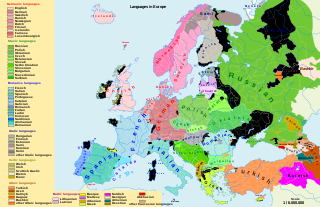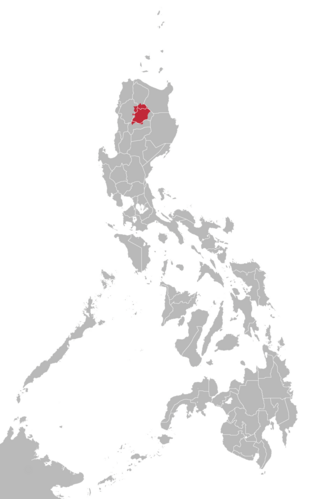Related Research Articles

There are over 250 languages indigenous to Europe, and most belong to the Indo-European language family. Out of a total European population of 744 million as of 2018, some 94% are native speakers of an Indo-European language. The three largest phyla of the Indo-European language family in Europe are Romance, Germanic, and Slavic; they have more than 200 million speakers each, and together account for close to 90% of Europeans.

Kalinga is a dialect continuum of Kalinga Province in the Philippines, spoken by the Kalinga people, alongside Ilocano. The Banao Itneg variety is not one of the neighboring Itneg languages.
Abellen, Abenlen, Aburlin, or Ayta Abellen, is a Sambalic language. It has about 3,500 speakers and is spoken in a few Aeta communities in Tarlac province, Philippines. Ayta Abellen itself is part of the Sambalic language family in the Philippines and is closely related to not only the five other Ayta dialects but also the Botolan dialect of Sambal. Ethnologue reports 45 monolinguists.

Berau Malay, or just Berau, is an Malayic language which is spoken by Berau Malays in Berau Regency, East Kalimantan, Indonesia. It is one three native Malayic varieties in southern and eastern Borneo along with Banjar and Kutai, of which it forms a dialect continuum.
Momuna (Momina), also known as Somahai, is a Papuan language spoken in Yahukimo Regency, Highland Papua and Asmat Regency, South Papua, Indonesia.
Cuối, known as Thổ, is a dialect cluster spoken by around 70,000 Thổ people in Vietnam and a couple thousand in Laos, mainly in the provinces of Bolikhamsai and Khammouane.
Kombai (Komboy) is a Papuan language of Boven Digoel Regency in Indonesian New Guinea. It is spoken by the Kombai people. Tayan is a dialect.
Yali is a Papuan language of Indonesian New Guinea. The Yali people live east of the Baliem Valley, in the Western Highlands.
Kayan, also known as, Padaung or Padaung Karen) is a Karen language of Burma, spoken by the Kayan people. The Kayan dialects share more than 90% lexical similarity. Padaung is 71% to 76% lexically similar to Lahta.
Matu, also known as Matu Chin, Batu, or Nga La, is a Kuki-Chin spoken in Matupi township, Chin State, Myanmar, and also in Mizoram, India by the Matu people. Matu is the most commonly spoken language in Matupi Township outside of Burmese language, which is the official language of Myanmar.
Ngbinda is a poorly documented Congolese Bantu language of uncertain affiliation. Prior to 1975 it had also been spoken in southern Sudan.
Kháng, also known as Mang U’, is an Austroasiatic language of Vietnam. It is closely related to the Bumang language of southern Yunnan, China.
Tai Laing, also known as Shan-ni, is a Tai language of Burma, closely related to Khamti and Shan. It is written in its own variant of Burmese script, and though not taught in schools, is experiencing a cultural revival, albeit still small. There is no census of speakers, but they are estimated to number around 100,000.
Mewahang (Meohang), or Newahang, is a Kiranti language spoken in Nepal. The eastern and western dialects are structurally distinct.
Taliang is a Bahnaric language spoken by the Jeh-Tariang people of Laos and Vietnam. It is possibly related to the Stieng language of Vietnam and Cambodia.
Yolŋu (Yolngu) or Penguin Sign Language is a ritual sign language used by the Yolngu, an Aboriginal community in the Arnhem Land region of Australia. As with other Australian Aboriginal sign languages, YSL was developed by the hearing for use when oral speech is forbidden, as during mourning or between certain family relations. However, "YSL is not a signed version of any spoken Yolngu language... YSL also serves as a primary means of communication for a number of deaf members in Yolngu communities... YSL functions as both an alternate and primary sign language". That is, it is used for communicating to the deaf, but also when communicating at a distance, when hunting, or when ceremonies require silence. It was acquired from birth by the hearing population. YSL is now considered an endangered language.
Central Yambasa or Nuasua (Nuaswa) is a Southern Bantoid language of Cameroon.
Kola is one of the Aru languages, spoken in the northernmost part of the Aru Islands, mainly on Kola Island and in the northern and western part of Wokam Island.
Koki, or Koki Naga, is an unclassified Sino-Tibetan language spoken in Burma. Speakers are included under the wider Naga ethnicity. It has been documented in Shintani (2018).
References
- ↑ Riang Lang at Ethnologue (18th ed., 2015) (subscription required)
Riang Lai at Ethnologue (18th ed., 2015) (subscription required) - ↑ Hall, Elizabeth. (2018) A phonological analysis of Riang Lang. Journal of the Southeast Asian Linguistic Society (JSEALS), 11:2.
- Shintani Tadahiko. 2014. The Riang language. Linguistic survey of Tay cultural area (LSTCA) no. 101. Tokyo: Research Institute for Languages and Cultures of Asia and Africa (ILCAA).